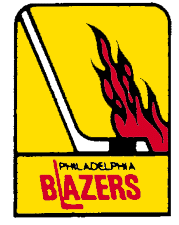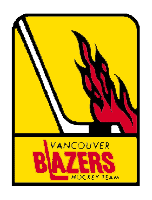
Miami Screaming Eagles
Eagles/Blazers/Cowboys-in-brief
- Home ice: Proposed Miami Arena 1972, Philadelphia Civic Center (9,100) 1972-73, Pacific
Coliseum (15,569) 1973-75, Stampede Corral (6,445) 1975-77
- Colors: Red and White 1972, Red and Yellow 1972-75, Red and White 1975-77
The Miami Screaming Eagles were to have been Florida's
World Hockey Association team. The team was part of the WHA's grand plan
to put a team in the then hockey void of the southern United States.
League co-founder Dennis Murphy (who would later be involved in Roller Hockey International) had an
involvement with the ABA's Miami Floridians, and Miami was granted a
franchise, contigent on a new arena. The team conceived a uniform and season ticket campaign, but needed to have an arena as well. The Screaming Eagles made immediate
news when Toronto Maple Leafs goalie Bernie Parent was acquired. Boston
Bruins forward Derek Sanderson was next in line when Miami withdrew from
the league in April 1972 due to a lack of funds and no arena. The league
took control of the now-homeless franchise, and re-awarded it to
Philadelphia.

Philadelphia Blazers

Now known as the Philadelphia Blazers, the team was able to
keep Parent and sign Sanderson. John McKenzie, also of the Bruins, was
named player-coach. Playing at the antique Philadelphia Civic Center,
the team struggled, as all three stars were injured early on. Parent and
McKenzie eventually were back on the ice, but the Blazers bought out
Sanderson's contract. Attendance was a problem, as the cross-town Flyers
were doing well. The team made the playoffs, and was swept by Cleveland. The owners had grown
disenfranchised with the team, and it was sold to Canadian businessman
Jim Pattison, and moved to Vancouver's Pacific Coliseum.

Vancouver Blazers


Now in Vancouver, the team started off better in 1973. Attendance was
steady at 9,356 per game, even though the club finished in 5th place,
missing the playoffs. In 1974-75, the team improved to 4th place in the
Canadian Division, but attendance slumped to 8,014, as the Canucks were
improving. Due to the bizarre playoff format, which took the top two
teams in each division as well as two more US entries, the Blazers did
not qualify. So, owner Jim Pattison decided to move the team across the
Rockies to Calgary. Calgary was an original site for a WHA club, the
Broncos, but they ended up in Cleveland.

Calgary Cowboys


The third home for the franchise, the Calgary Stampede Corral, seemed
to fit the Cowboys. They improved to 41-35-4, which gave them a playoff
spot. They beat Quebec before losing to Winnipeg. Attendance was a
promising 4,948 in the 8,945 seat Corral. In 1976-77, the club collapsed
to a record of 31-43-7, missing the playoffs. The Cowboys realized the
Calgary future was growing dim, as they needed a new arena, and none was
in sight.
The 1988 Olympics would not be awarded for several years. So,
the club considered moving to Ottawa, former home of the Nationals and Civics.
This alone canceled the move. So, the club decided to hang around for
the 1977-78 season contingent on season ticket sales. Unfortunately, sales
did not meet expectations. Calgary folded on May 31, 1977, having
played its last game on April 7, losing 6-4 to Winnipeg. Had the
Saddledome been built earlier, the Cowboys would have been far more
successful. As well, had the club made to 1979, they would have been a
prime candidate for entry into the NHL, being a convenient rival for
Edmonton.
Blazers/Cowboys year-by-year
Year W L T pts. Finish Playoffs
1972-73 38 40 0 76 3rd Eastern Lost to Cleveland 0-4
1973-74 27 50 1 55 5th Western None
1974-75 37 39 2 76 4th Canadian None
1975-76 41 35 4 86 3rd Canadian Beat Quebec 4-1
Lost to Winnipeg 1-4
1976-77 31 43 7 69 5th Western None
Information on this page is from The Complete Historical
and Statistical Reference to the World Hockey Associaltion
1972-1979; by Scott Adam Surgent.









